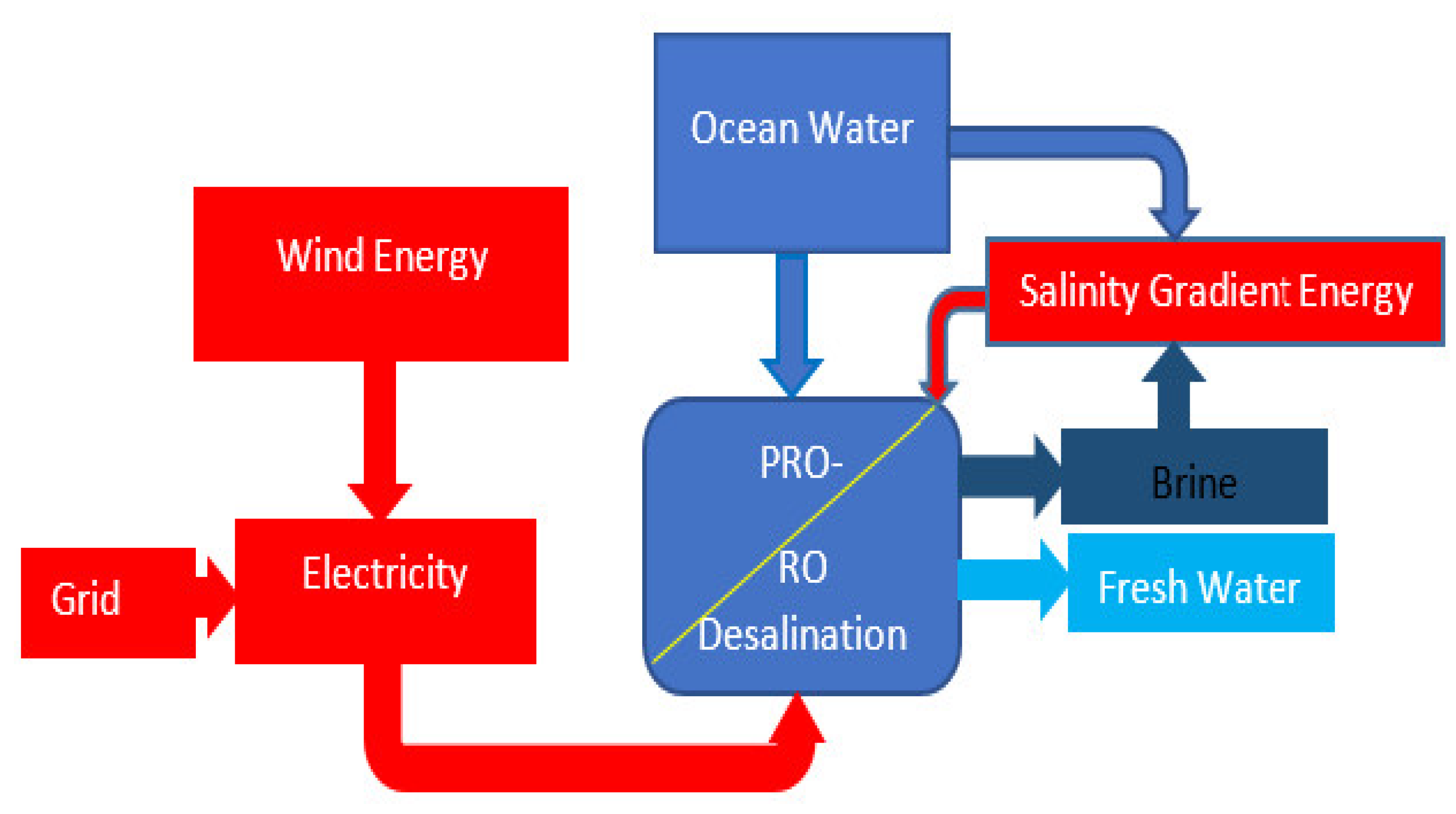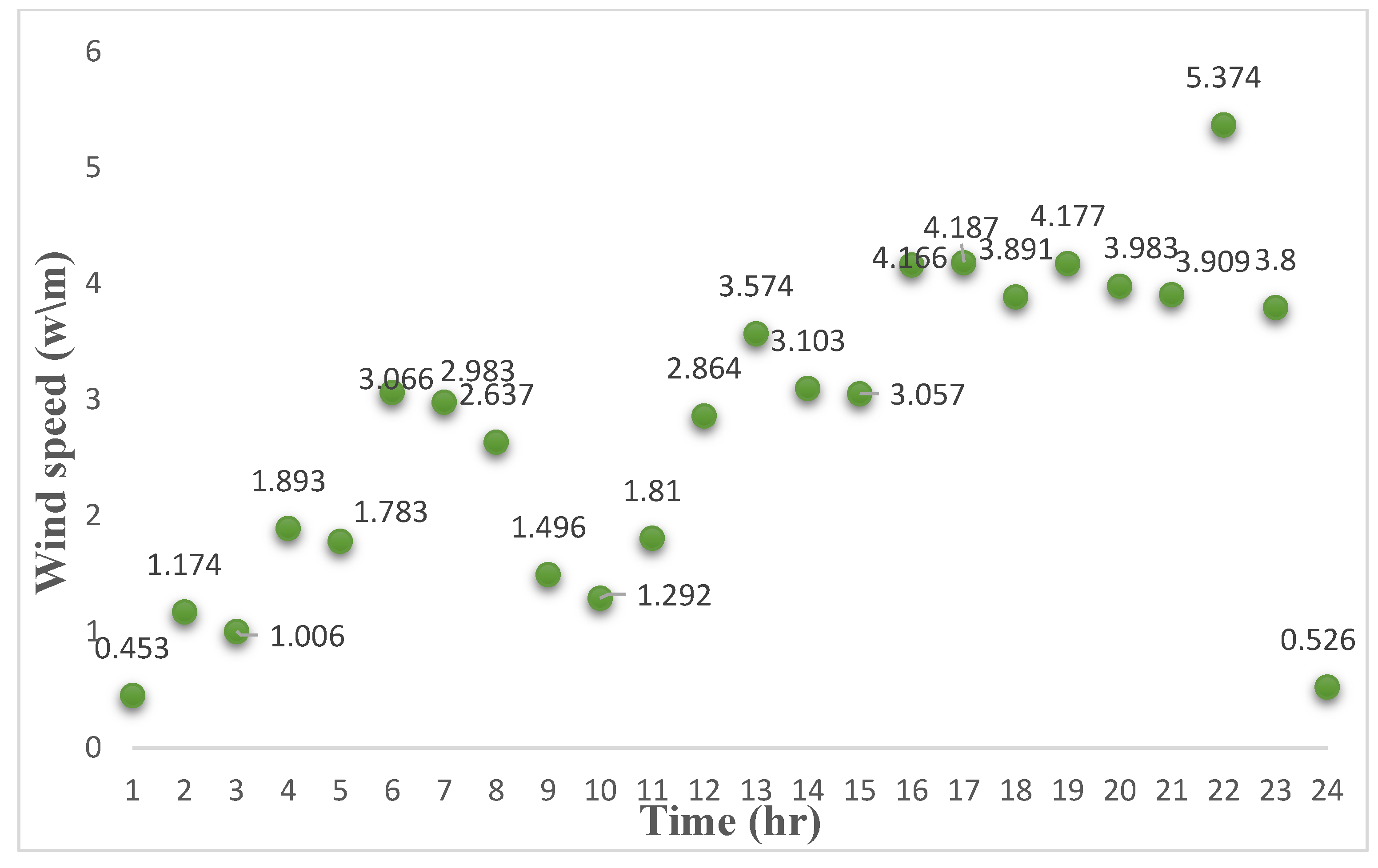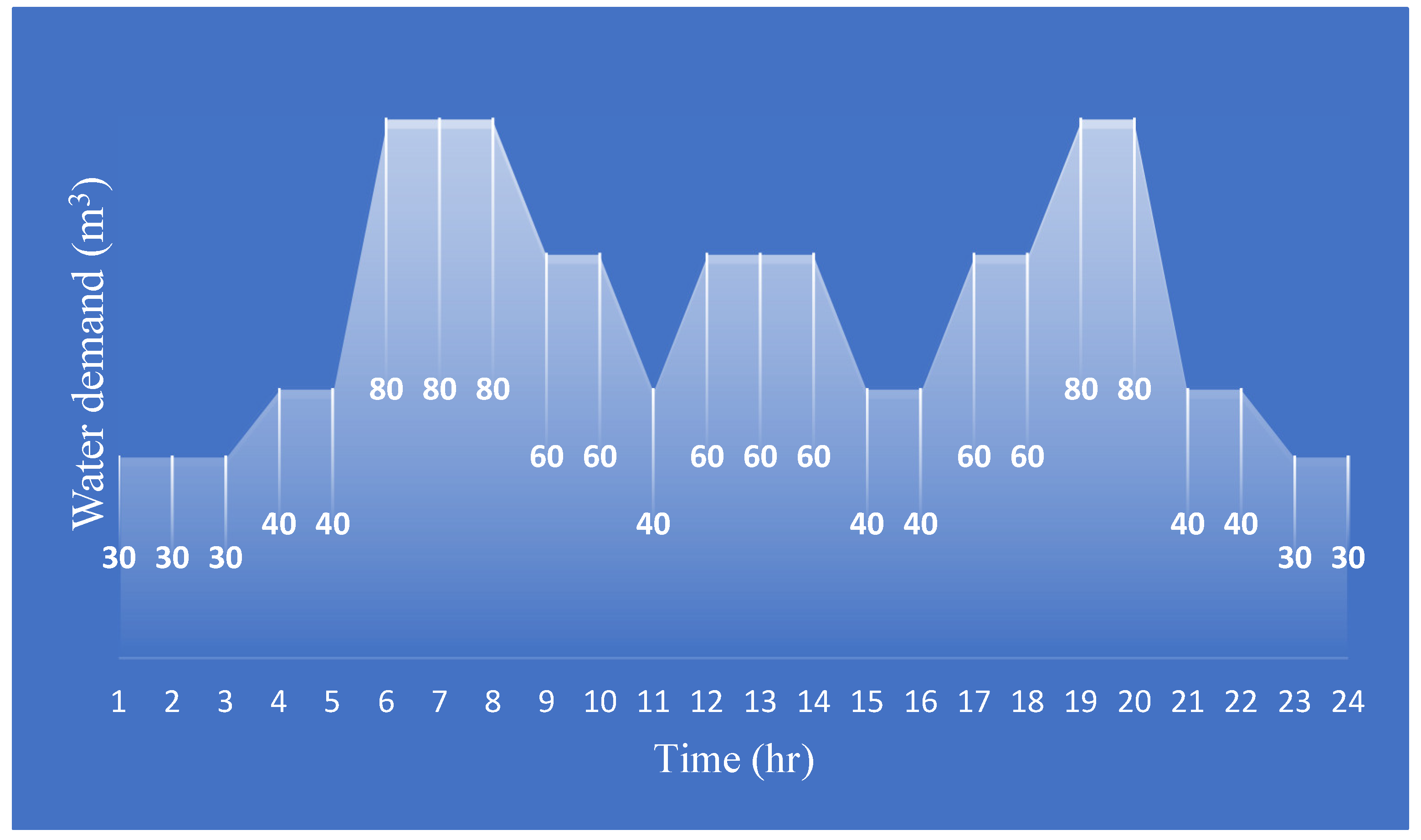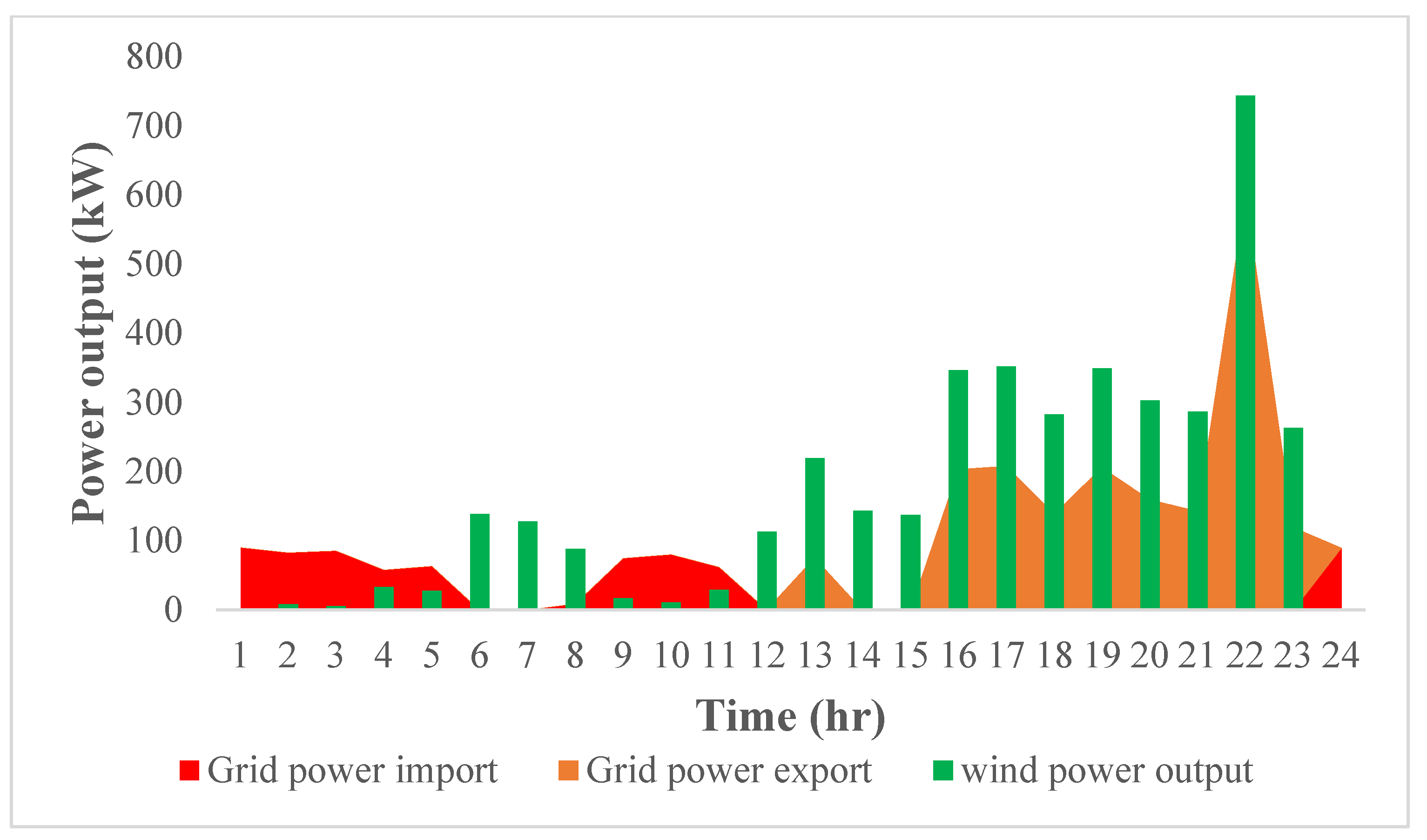Economic and Reliability Assessment of Hybrid PRO-RO Desalination Systems Using Brine for Salinity Gradient Energy Production
Abstract
:1. Introduction
1.1. Background and Motivation of Study
1.2. Environmental Impacts and Treatment of Brine
2. Materials and Methods
2.1. System Architecture
2.2. Salinity Gradient Energy
2.3. PRO Power and Cost Model
2.4. Wind Power and Cost Model
2.5. Grid Power, Cost, and Carbon Emission Factor
2.6. RO Desalination Power Demand and Cost Model
2.7. Economic and Reliability Assessment
Cost Optimization Problem Formulation
2.8. Reliability Assessment
3. Results and Discussion
4. Conclusions
Author Contributions
Funding
Acknowledgments
Conflicts of Interest
Abbreviations
| FO | Forward osmosis |
| PRO | Pressure-retarded osmosis |
| RO | Reverse osmosis |
| ROD | Reverse osmosis desalination |
| UNGA | United Nations General Assembly |
| Set | |
| t | time (hr) |
| Parameters | |
| v | Partial molar volume (m3 mol−1) |
| V | Total volume of concentration (mol m3) |
| c | Molar concentration (mol m3) |
| x | Mole fraction (mol−1) |
| z | Valence of ion (equiv/mol) |
| F | Faraday constant (c/equiv) |
| R | Gas constant (J mol−1 K−1) |
| T | Absolute temperature (K) |
| G | Gibbs free energy (J) |
| n | Number of moles |
| Chemical potential (J mol−1) | |
| Chemical potential under standard condition (J mol−1) | |
| Pressure gradient (Pa) | |
| Electrical potential difference (V) | |
| γ | Activity coefficient |
| Gibbs free energy of the mixed solution (J) | |
| Mixed solution | |
| Concentrated solution | |
| Dilute solution | |
| Osmotic water flux (m3 m−2 h−1) | |
| Osmotic pressure difference (Pa) | |
| Hydrostatic pressure difference (Pa) | |
| Membrane water permeability (ms−1 Pa−1) | |
| Power density (Wm−2) | |
| Maximum power density (Wm−2) | |
| Salinity gradient power generated (kW) | |
| Salinity gradient power consumed (kW) | |
| Efficiency of wind generator | |
| Air density | |
| Power coefficient | |
| V(t)3 | Hourly wind speed (W/m) |
| h | Projected wind turbine height (m) |
| VR | Reference wind speed (W/m) |
| hR | Reference wind turbine height (m) |
| α | Power law exponent |
| Initial capital cost of wind turbine ($) | |
| Cost of wind turbine ($) | |
| Maintenance cost of wind generator ($) | |
| Annual maintenance cost of the wind generator ($) | |
| Cost of maintenance of a wind turbine ($) | |
| r | Discount rate |
| CRF | Capital recovery factor |
| SEC | Specific energy consumption (kWh/m3) |
| WD(t) | Hourly water demand (m3) |
| Initial capital cost of RO ($/m3/day) | |
| CRO | RO cost ($/m3) |
| ACCH | Annual cost of RO treatment chemicals ($) |
| ACMR | Annual cost of RO membrane replacement ($) |
| AMCRO | RO annual maintenance cost ($) |
| CPRO | PRO cost ($/m3) |
| Initial capital cost of PRO ($/m3/day) | |
| AMCPRO | PRO annual maintenance cost ($) |
| Water tank capacity (m3) | |
| CWTK | Water tank cost ($/m3) |
| CWT | Wind turbine cost ($) |
| ICWTK | Initial capital cost of the water tank ($) |
| TICC | Total initial capital cost of system ($) |
| TMC | Total maintenance and operational cost ($) |
| Minimum and maximum water produce (m3) | |
| Minimum and maximum power demand (kW) | |
| W1, W2 | Weighting factor |
| j | Capacity outage state |
| State probability of j | |
| Outage duration of j | |
| Variables | |
| Hourly power demand by RO unit (kW) | |
| Hourly volume of water produced (m3) | |
| Daily water production capacity (m3) | |
| Swept area of wind turbine (m) | |
| Hourly power wind generator power output (kW) | |
| Hourly net salinity gradient power out (kW) | |
| Grid power imported (kW) | |
| Grid power exported (kW) | |
| COW | Cost of water ($/m3) |
| ACS | Annualized cost of system ($) |
| LCOE | Levelized cost of energy ($) |
| LOLP | Loss of load probability |
References
- Prathapaneni, D.R.; Detroja, K. Optimal design of energy sources and reverse osmosis desalination plant with demand side management for cost-effective freshwater production. Desalination 2020, 496, 114741. [Google Scholar] [CrossRef]
- Abdelkareem, M.A.; El Haj Assad, M.; Sayed, E.T.; Soudan, B. Recent progress in the use of renewable energy sources to power water desalination plants. Desalination 2018, 435, 97–113. [Google Scholar] [CrossRef]
- Ghenai, C.; Merabet, A.; Salameh, T.; Pigem, E.C. Grid-tied and stand-alone hybrid solar power system for desalination plant. Desalination 2018, 435, 172–180. [Google Scholar] [CrossRef]
- Abdelshafy, A.M.; Hassan, H.; Jurasz, J. Optimal design of a grid-connected desalination plant powered by renewable energy resources using a hybrid PSO–GWO approach. Energy Convers. Manag. 2018, 173, 331–347. [Google Scholar] [CrossRef]
- Okampo, E.J.; Nwulu, N.I. Optimal energy mix for a reverse osmosis desalination unit considering demand response osmosis. J. Eng. Des. Technol. 2020, 18, 1287–1303. [Google Scholar] [CrossRef]
- Koutroulis, E.; Kolokotsa, D. Design optimization of desalination systems power-supplied by PV and W/G energy sources. Desalination 2010, 258, 171–181. [Google Scholar] [CrossRef]
- Smaoui, M.; Abdelkafi, A.; Krichen, L. Optimal sizing of stand-alone photovoltaic/wind/hydrogen hybrid system supplying a desalination unit. Sol. Energy 2015, 120, 263–276. [Google Scholar] [CrossRef]
- Wu, B.; Maleki, A.; Pourfayaz, F.; Rosen, M.A. Optimal design of stand-alone reverse osmosis desalination driven by a photovoltaic and diesel generator hybrid system. Sol. Energy 2018, 163, 91–103. [Google Scholar] [CrossRef]
- Okampo, E.J.; Nwulu, N. Optimisation of renewable energy powered reverse osmosis desalination systems: A state-of-the-art review. Renew. Sustain. Energy Rev. 2021, 140, 110712. [Google Scholar] [CrossRef]
- Pohl, R.; Kaltschmitt, M.; Holländer, R. Investigation of different operational strategies for the variable operation of a simple reverse osmosis unit. Desalination 2009, 249, 1280–1287. [Google Scholar] [CrossRef]
- Ghobeity, A.; Mitsos, A. Optimal time-dependent operation of seawater reverse osmosis. Desalination 2010, 263, 76–88. [Google Scholar] [CrossRef]
- Ruiz-García, A.; Nuez, I. Performance evaluation and boron rejection in a SWRO system under variable operating conditions. Comput. Chem. Eng. 2021, 153, 107441. [Google Scholar] [CrossRef]
- Okampo, E.J.; Nwulu, N. Optimal design and techno-economic evaluation of renewable energy powered combined reverse osmosis desalination and brine treatment unit. Desalin. Water Treat. 2020, 202, 27–37. [Google Scholar] [CrossRef]
- Nayar, K.G.; Fernandes, J.; Mcgovern, R.K.; Dominguez, K.P.; Mccance, A.; Al-anzi, B.S.; Lienhard, J.H. Cost and energy requirements of hybrid RO and ED brine concentration systems for salt production. Desalination 2019, 456, 97–120. [Google Scholar] [CrossRef]
- Li, Z.; Siddiqi, A.; Anadon, L.D.; Narayanamurti, V. Towards sustainability in water-energy nexus: Ocean energy for seawater desalination. Renew. Sustain. Energy Rev. 2018, 82, 3833–3847. [Google Scholar] [CrossRef] [Green Version]
- Teow, Y.H.; Mohammad, A.W. New generation nanomaterials for water desalination: A review. Desalination 2019, 451, 2–17. [Google Scholar] [CrossRef]
- Mamah, S.C.; Goh, P.S.; Ismail, A.F.; Suzaimi, N.D.; Ahmad, N.A.; Lee, W.J. Flux enhancement in reverse osmosis membranes induced by synergistic effect of incorporated palygorskite/chitin hybrid nanomaterial. J. Environ. Chem. Eng. 2021, 9, 105432. [Google Scholar] [CrossRef]
- Ng, Z.C.; Lau, W.J.; Matsuura, T.; Ismail, A.F. Thin film nanocomposite RO membranes: Review on fabrication techniques and impacts of nanofiller characteristics on membrane properties. Chem. Eng. Res. Des. 2021, 165, 81–105. [Google Scholar] [CrossRef]
- Nayar, K.G.; Fernandes, J.; McGovern, R.K.; Al-Anzi, B.S.; Lienhard, J.H. Cost and energy needs of RO-ED-crystallizer systems for zero brine discharge seawater desalination. Desalination 2019, 457, 115–132. [Google Scholar] [CrossRef]
- Yangali-Quintanilla, V.; Li, Z.; Valladares, R.; Li, Q.; Amy, G. Indirect desalination of Red Sea water with forward osmosis and low pressure reverse osmosis for water reuse. Desalination 2011, 280, 160–166. [Google Scholar] [CrossRef]
- Valladares Linares, R.; Li, Z.; Abu-Ghdaib, M.; Wei, C.H.; Amy, G.; Vrouwenvelder, J.S. Water harvesting from municipal wastewater via osmotic gradient: An evaluation of process performance. J. Memb. Sci. 2013, 447, 50–56. [Google Scholar] [CrossRef]
- Valladares Linares, R.; Li, Z.; Yangali-Quintanilla, V.; Ghaffour, N.; Amy, G.; Leiknes, T.; Vrouwenvelder, J.S. Life cycle cost of a hybrid forward osmosis—Low pressure reverse osmosis system for seawater desalination and wastewater recovery. Water Res. 2016, 88, 225–234. [Google Scholar] [CrossRef] [Green Version]
- Panagopoulos, A.; Haralambous, K.; Loizidou, M. Desalination brine disposal methods and treatment technologies—A review. Sci. Total Environ. 2019, 693, 133545. [Google Scholar] [CrossRef]
- Molinos-Senante, M.; González, D. Evaluation of the economics of desalination by integrating greenhouse gas emission costs: An empirical application for Chile. Renew. Energy 2018, 133, 1327–1337. [Google Scholar] [CrossRef]
- Panagopoulos, A.; Loizidou, M.; Haralambous, K.J. Stainless Steel in Thermal Desalination and Brine Treatment: Current Status and Prospects. Met. Mater. Int. 2020, 26, 1463–1482. [Google Scholar] [CrossRef]
- Panagopoulos, A.; Haralambous, K. Environmental impacts of desalination and brine treatment—Challenges and mitigation measures. Mar. Pollut. Bull. 2020, 161, 111773. [Google Scholar] [CrossRef]
- Roberts, D.A.; Johnston, E.L.; Knott, N.A. Impacts of desalination plant discharges on the marine environment: A critical review of published studies. Water Res. 2010, 44, 5117–5128. [Google Scholar] [CrossRef]
- Lior, N. Sustainability as the quantitative norm for water desalination impacts. Desalination 2017, 401, 99–111. [Google Scholar] [CrossRef]
- Mannan, M.; Alhaj, M.; Mabrouk, A.N.; Al-Ghamdi, S.G. Examining the life-cycle environmental impacts of desalination: A case study in the State of Qatar. Desalination 2019, 452, 238–246. [Google Scholar] [CrossRef]
- Jia, Z.; Wang, B.; Song, S.; Fan, Y. Blue energy: Current technologies for sustainable power generation from water salinity gradient. Renew. Sustain. Energy Rev. 2014, 31, 91–100. [Google Scholar] [CrossRef]
- Tufa, R.A.; Curcio, E.; Fontananova, E.; Di Profio, G. Membrane-based processes for sustainable power generation using water: Pressure-retarded osmosis (PRO), reverse electrodialysis (RED), and capacitive mixing (CAPMIX). In Comprehensive Membrane Science and Engineering, 2nd ed.; Elsevier: Amsterdam, The Netherlands, 2017; pp. 206–248. [Google Scholar]
- Kim, Y.C.; Elimelech, M. Potential of osmotic power generation by pressure retarded osmosis using seawater as feed solution: Analysis and experiments. J. Memb. Sci. 2013, 429, 330–337. [Google Scholar] [CrossRef]
- Long, R.; Lai, X.; Liu, Z.; Liu, W. Pressure retarded osmosis: Operating in a compromise between power density and energy efficiency. Energy 2019, 172, 592–598. [Google Scholar] [CrossRef]
- Sakai, H.; Ueyama, T.; Irie, M.; Matsuyama, K.; Tanioka, A.; Saito, K.; Kumano, A. Energy recovery by PRO in sea water desalination plant. Desalination 2016, 389, 52–57. [Google Scholar] [CrossRef]
- Matsuyama, K.; Makabe, R.; Ueyama, T.; Sakai, H.; Saito, K.; Okumura, T.; Hayashi, H.; Tanioka, A. Power generation system based on pressure retarded osmosis with a commercially-available hollow fiber PRO membrane module using seawater and freshwater. Desalination 2021, 499, 114805. [Google Scholar] [CrossRef]
- Makabe, R.; Ueyama, T.; Sakai, H.; Tanioka, A. Commercial pressure retarded osmosis systems for seawater desalination plants. Membranes 2021, 11, 69. [Google Scholar] [CrossRef]
- Loeb, S. Large-scale power production by pressure-retarded osmosis, using river water and sea water passing through spiral modules. Desalination 2002, 143, 115–122. [Google Scholar] [CrossRef]
- Nwulu, N.I.; Xia, X. Optimal dispatch for a microgrid incorporating renewables and demand response. Renew. Energy 2017, 101, 16–28. [Google Scholar] [CrossRef]
- Salameh, Z.M.; Borowy, B.S. Methodology for Optimally Sizing the Combination of a Battery Bank and PV Array in a Wind/PV Hybrid System. IEEE Trans. Energy Convers. 1996, 11, 367–375. [Google Scholar] [CrossRef]
- Okampo, E.J.; Nwulu, N. Techno-economic evaluation of reverse osmosis desalination system considering emission cost and demand response. Sustain. Energy Technol. Assess. 2021, 46, 101252. [Google Scholar] [CrossRef]
- Naserisafavi, N.; Yaghoubi, E.; Sharma, A.K. Alternative water supply systems to achieve the net zero water use goal in high-density mixed-use buildings. Sustain. Cities Soc. 2021, 76, 103414. [Google Scholar] [CrossRef]
- Kesieme, U.K.; Milne, N.; Aral, H.; Yong, C.; Duke, M. Economic analysis of desalination technologies in the context of carbon pricing, and opportunities for membrane distillation. Desalination 2013, 323, 66–74. [Google Scholar] [CrossRef] [Green Version]
- Brander, A.M.; Sood, A.; Wylie, C.; Haughton, A.; Lovell, J.; Reviewers, I.; Davis, G. Technical Paper|Electricity-Specific Emission Factors for Grid Electricity. Available online: https://ecometrica.com/assets/Electricityspecific-emission-factors-for-grid-electricity.pdf. (accessed on 15 February 2022).
- Maleki, A.; Khajeh, M.G.; Rosen, M.A. Weather forecasting for optimization of a hybrid solar-wind–powered reverse osmosis water desalination system using a novel optimizer approach. Energy 2016, 114, 1120–1134. [Google Scholar] [CrossRef]
- Peng, W.; Maleki, A.; Rosen, M.A.; Azarikhah, P. Optimization of a hybrid system for solar-wind-based water desalination by reverse osmosis: Comparison of approaches. Desalination 2018, 442, 16–31. [Google Scholar] [CrossRef]
- Acuña, L.G.; Lake, M.; Padilla, R.V.; Lim, Y.Y.; Ponzón, E.G.; Soo Too, Y.C. Modelling autonomous hybrid photovoltaic-wind energy systems under a new reliability approach. Energy Convers. Manag. 2018, 172, 357–369. [Google Scholar] [CrossRef]
- Al-Obaidi, M.A.; Filippini, G.; Manenti, F.; Mujtaba, I.M. Cost evaluation and optimisation of hybrid multi effect distillation and reverse osmosis system for seawater desalination. Desalination 2019, 456, 136–149. [Google Scholar] [CrossRef] [Green Version]
- Koroneos, C.; Dompros, A.; Roumbas, G. Renewable energy driven desalination systems modelling. J. Clean. Prod. 2007, 15, 449–464. [Google Scholar] [CrossRef]
- Gbadamosi, S.L.; Nwulu, N.I. Optimal power dispatch and reliability analysis of hybrid CHP-PV-wind systems in farming applications. Sustainability 2020, 12, 8199. [Google Scholar] [CrossRef]







| Parameters | Value | Parameters | Value | Parameters | Value |
|---|---|---|---|---|---|
| Project time | 20 years | Cp | 0.59 | B | 0.85 Lm−2 h−1 |
| Interest rate | 5% | CWT | $1804 | 25.35 bar | |
| Discount rate | 3% | CRO | 532 $/m3/day | A | 4.0 Lm−2 h−1 |
| Emission factor | 1.07 | Plant maintenance cost | 0.2 $/m3 | WT rated power | 1 kW |
| Emission tax | 0.41 $ | Chemical cost | 0.6 $/m3 | CMR | 0.6 $/m3 |
| 85% | CWTK | 255 $/m3 | ρair | 1.23 kg m3 |
| ACS ($) | LCOE ($/kW) | COW ($/m3) | Emission (kgCO2-e) | Emission Cost ($) | Daily Water Produced (m3) | AWT (m2) | JW (m3 m−2 h−1) |
|---|---|---|---|---|---|---|---|
| 110,456 | 1.11 | 0.13 | 269,405 | 110,456 | 2384 | 15,543 | 17.031 |
Publisher’s Note: MDPI stays neutral with regard to jurisdictional claims in published maps and institutional affiliations. |
© 2022 by the authors. Licensee MDPI, Basel, Switzerland. This article is an open access article distributed under the terms and conditions of the Creative Commons Attribution (CC BY) license (https://creativecommons.org/licenses/by/4.0/).
Share and Cite
Okampo, E.J.; Nwulu, N.; Bokoro, P.N. Economic and Reliability Assessment of Hybrid PRO-RO Desalination Systems Using Brine for Salinity Gradient Energy Production. Sustainability 2022, 14, 3328. https://doi.org/10.3390/su14063328
Okampo EJ, Nwulu N, Bokoro PN. Economic and Reliability Assessment of Hybrid PRO-RO Desalination Systems Using Brine for Salinity Gradient Energy Production. Sustainability. 2022; 14(6):3328. https://doi.org/10.3390/su14063328
Chicago/Turabian StyleOkampo, Ewaoche John, Nnamdi Nwulu, and Pitshou N. Bokoro. 2022. "Economic and Reliability Assessment of Hybrid PRO-RO Desalination Systems Using Brine for Salinity Gradient Energy Production" Sustainability 14, no. 6: 3328. https://doi.org/10.3390/su14063328
APA StyleOkampo, E. J., Nwulu, N., & Bokoro, P. N. (2022). Economic and Reliability Assessment of Hybrid PRO-RO Desalination Systems Using Brine for Salinity Gradient Energy Production. Sustainability, 14(6), 3328. https://doi.org/10.3390/su14063328







